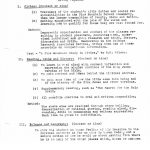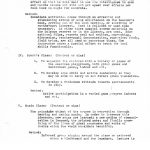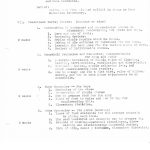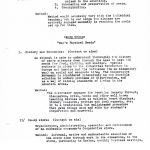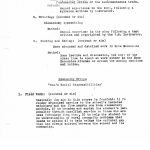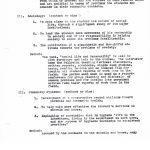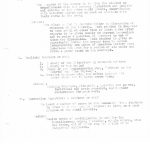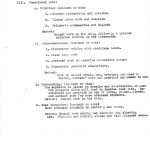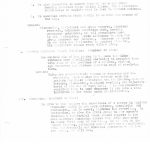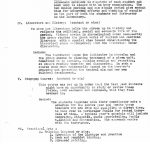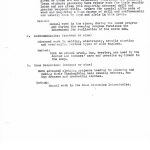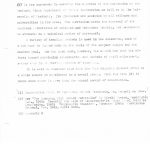Pine Mountain Settlement School
Series 07: Directors – Glyn Morris
GLYN MORRIS STUDY & RECOMMENDATIONS III CURRICULUM
TAGS: Glyn Morris Study & Recommendations III Curriculum; educational study; institutional reports; institutional management; educational recommendations; Curriculum; methods; community groups; field work; recreation supervision; Christian ethics; current American social problems; stop-gap courses;
GALLERY: Glyn Morris Study & Recommendations III Curriculum (pp. 29-41)
- morris_study_03 (29)
- morris_study_03 (30)
- morris_study_03 (31)
- morris_study_03 (32)
- morris_study_03 (33)
- morris_study_03 (34)
- morris_study_03 (35)
- morris_study_03 (36)
- morris_study_03 (37)
- morris_study_03 (38)
- morris_study_03 (39)
- morris_study_03 (40)
- morris_study_03 (41)
TRANSCRIPTION: Glyn Morris Study & Recommendations III Curriculum
[Slightly edited.]
[morris_study_03-29.jpg]
29.
III
CURRICULUM
“Living Together”
I. Civics: (Content or Aims)
- Treatment of the student’s civic duties and social responsibilities in the Pine Mountain School community, then the larger communities of County, State and Nation.
- Getting acquainted with the jobs of the world and learning how to qualify for those they are best fitted for.
Method;
Democratic organization and conduct of the classes resulting in student presiders, committee work, supervised individual and group research and study, lecture, discussion and drill. Membership in the Science Research Associates Service brings them use of their materials on occupational information.
Text — “A Pine Mountain Study in Civics,” by [Everett] K. Wilson.
II. Reading, Bible and History: (Content or Aims)
- To learn to read aloud with correct inflection and expression the simpler portions of the King James version of the BIble.
- To gain content and ideas behind the BIblical stories.
- To gain some idea of how the Bible came into being and of the history of the King James and other versions.
- Supplementary reading, such as, “The Search for the Holy Grail.”
- All possible practice in oral and written composition.
Method:
The above aims are realized through storytelling, dramatization of Biblical stories, reading aloud, discussion, drill in penmanship and written expression. Much time is given to individuals.
III. Science and Geography: (Content or Aims)
To give the student an inner feeling of his location in the physical universe as far as that is known today, and a secure notion of how he would go about getting from where he is to many of the other places which, known or unknown…
[morris_study_03-30.jpg]
30.
…to him, have a vital bearing on his life as an American citizen.
To make the student personally familiar with some of the ways in which man uses his puny strength to advantage and gets things done; to give him a sympathetic feeling for other life about him — plant, animal and human — and his responsibility to help make the mutual dependence a mutually helpful and constructive relationship; to give him enough personal experience of the workings of cause and effect so that he will want to use his intelligence to seek and handle causes and will not get upset over effects nor fall back on magic for controls.
Method:
Immediate motivation comes through an arresting and stimulating set-up of some experiment on the teacher’s desk, growing out of the last meeting, or something of on-the-spot interest. Text is followed or used when necessary. All other times special source materials on the Science reserve or in the LIbrary, are used. Educational films, reports oral and written, map-making, discussion, teacher-pupil demonstration, supervised study, field trips, are all used at opportune times. The instructor makes a special effort to teach the tool skills functionally.
IV. Sports Class: (Content or Aims)
1. To acquaint the children with a variety of games of the American playground, both group games and individual games, indoor and out.
2, To develop some skill and active leadership so they may be able to carry on and direct games themselves.
3. To develop a wholesome attitude towards sportsmanship in play.
Method:
Active participation in a varied game program indoors and out.
V. Music Class: (Content or Aims)
The principal object of the course is recreation through hearing and making music. In order to increase this pleasure, new songs are learned; a new medium of communication is learned; the printed note; and finally something of the lives of great composers and works of theirs which the world considers beautiful.
Method:
Informal group singing around the piano or gathered about a blackboard and the Capehart. Lecture is…
[morris_study_03-31.jpg]
31.
…cut to a minimum while most of the time is spent singing together, listening, discussing, or using the blackboard for drill in fundamentals of music and learning to read notes.
VI. Vocational Elective: (Content or Aims)
A. Woodworking (A condensed and concentrated course in elementary woodworking, for girls and boys. (9 weeks)
- Care and use of tools.
- Fastening devices.
- Making simple repairs about the house.
- Making simple articles of furniture for the home.
- Learning the best uses for the various kinds of wood.
- Project of individual’s choice.
B. Household Mechanics and Elementary Auto-mechanics for boys and girls (9 weeks)
- A working knowledge of simple rules of plumbing, heating, refrigeration, ventilation and electricity.
- Sharpening knives, simple soldering jobs and other miscellaneous home repairs.
- How to change and fix a flat tire, rules of highway safety and how to make minor adjustments on an automobile.
C. Home Economics — for boys (9 weeks)
- Mechanics of the stove.
- Preparation of simple dishes.
- How to prepare food for the sick.
- Kinds of food to raise and how to buy for supplementing this.
- Elementary dietetics.
D. Home Economics — for girls (cooking) (9 weeks)
- Types of food available for the average mountain or mining camp home.
- The most healthful and economic way to prepare it.
- Methods of working — personal cleanliness, dishwashing and miscellaneous household duties.
- Care of milk, canning techniques, elementary dietetics.
[morris_study_03-32.jpg]
32.
E. Home Economics — Girls — Sewing (9 weeks)
- Simple sewing projects with fundamentals.
- Making of evening dress for annual Thanksgiving Ball and a May Day dress.
F. Agriculture — for Boys
- Study of vegetables that grow best in this area, nature of soil, season lengths, etc.
- How to care for livestock and poultry raised in the mountains.
- Butchering and preservation of meats.
- Transplanting.
Method:
Method would naturally vary with the individual teacher, but by and large, the classes are actively engaged manually in reaching the goals set up for them.
Co-op Groups
“Man’s Physical Needs”
l. History and Economics: (Content or Aims)
An attempt is made to understand thoroughly the history of man’s attempts down through the ages to meet his needs for food, clothing and shelter. Special emphasis is given to the Industrial Revolution in Europe and America and its influence (in an elementary way) on social and economic life. The Cooperative Movement is considered intensively as one possible solution to modern problems of distribution, and as a way of raising standards of living in the mountain areas.
Method:
The instructor manages the teaching largely through discussion, drill, tests and other well-known teaching devices such as bulletin board displays, library research, written and oral reports, etc. It is a traditional but enlightened procedure that gets things done and wins the student’s cooperation and approval.
II. Co-op Store: (Content or Aims)
Organization, administration, operation and maintenance of an authentic consumer’s Cooperative store.
Method:
Informal, active and enthusiastic execution of the above aims through work in the classroom, in the store, purchasing in Harlan, monthly business meetings,…
[morris_study_03-33.jpg]
33.
…and special assemblies to advance consumer education on the campus.
III. Biology: (Content or Aims)
To give the student an intelligent insight into the world of living things, a first-hand recognition of life processes, i.e., of the struggle of living things for energy and their interdependence in this and of how energy may be conserved and fruitfully used.
More specifically, to make the student critically aware of the world of flora and fauna about him here at Pine Mountain and of his fitting place therein, for his own survival and happiness as a part of life’s milieu today and through the generations.
Method:
The class usually begins the two-hour period with supervised study, followed by a question and answer period, students doing as much of both as possible. Out of this comes one of three things:
A vigorous attack upon the literature in search of answers, or
- The setting up of an experiment to “find out,” or
- The planning or immediate holding of a field trip “to see.”
Definite reading assignments are given for homework which are discussed at the next meeting. Functional treatment of the 3 R’s is not overlooked.
IV. English: (Content or Aims)
A rather thorough coverage of needs as felt or discovered by instructor and students in the areas of written and spoken English. This is allied wherever possible to other phases of their Co-op work resulting in jointly planned and achieved projects with other Co-op instructors, as in writing and printing the Co-op publicity materials and history, writing and producing a 14-scene play tracing the history of the Cooperative movement.
Method:
No text is used. Formal drill and the more informal (such as production of the stage play “Our Town” this year in class time) cooperative activities are used in about equal proportion.
V. Vocational Arts Classes: (electives) Woodworking, Auto-Mechanics, Printing, Cooking and Sewing.
A. Woodworking: (Content or Aims)
- To give this student more detailed work in the construction of useful projects for use in the home or on the market.
[morris_study_03-34.jpg]
34.
- To improve skills in the handling of tools and power machinery.
- To improve skills in general repairs.
Method:
Manual experience in the shop.
B. Auto-Mechanics: (Content or Aims)
More advanced but basic work only in the fundamental skills of the Auto-mechanics trade.
Method:
Manual experience in the shop, following a syllabus written by instructor.
C. Printing: (Content or Aims)
Elementary typesetting
Method:
Manual experience in the shop following a text written and copyrighted by the P.M. Instructor.
D. Cooking and Sewing: (Content or Aims)
More advanced and detailed work in Home Economics.
Method:
Some lecture and discussion, but most of the class time is spent at work either in the Home Economics kitchen or around the sewing machines and tables.
Community Groups
“Man’s Social Responsibilities”
I. Field Work: (Content or Aims)
Basically, the aim in this course is fourfold:
- To render organized service to the School’s isolated neighbors and the five nearby one-room elementary schools,
- To broaden and enrich the student’s personality through unselfish service to those who are less fortunate than they,
- To help the student to an understanding of rural community problems that leads to action [and]
- To help bridge the cultural gap that has always existed between the School and its community.
[morris_study_03-35.jpg]
35.
Method:
The class is divided into two sections, each having one day a week for field work. Work in the field consists of teams that go by bus to the rural schools, six girls who are home-visitors on as many creeks, teams of two that go as special helpers to the doctor, for community clinics, and a pack horse librarian. Several of their courses furnish a theoretical basis from which to proceed and the courses in turn receive depth and are modified in terms of problems the students encounter in their community contacts.
II. Sociology: (Content or Aims)
- To make clear to the student the nature of social life, through a significant study of its major institutions.
- To lead the student into awareness of his membership in society and of his responsibility in helping society to solve its problems intelligently.
- The cultivation of a sympathetic and thoughtful attitude towards the problems of society.
Method:
The text, “Social Life and Personality,” is used to give structure and body to the course. The instructor uses the following teaching devices: Discussion, written reports, notebooks, simple case studies, tests, reading lessons and an indexed file for keeping all student reports of work done in the field. One period each week is used as a report-conference for group planning and discussion of common problems and for putting into permanent written form their reports of work done in the field.
III. Community Hygiene: (Content or Aims)
- Development of a constructive mental attitude toward personal and community health.
- To help make more effective the student’s services in schools and homes.
- Implanting of conviction that in hygiene “life is the laboratory, living is the experiment we work upon, and the purpose of hygienic knowledge is consistent practice.”
Method:
Aroused by the contacts in the schools and homes, many…
[morris_study_03-36.jpg]
36.
….sorts of ailments and treatments are brought up for discussion in class regularly. In addition to this provision is made also for assigned readings from books on health reserve shelf, carefully kept notebooks, drawings on board, vocabulary tests and question and answer.
IV. Current HIstory: (Content or Aims)
The purpose of the course is to give the student an acquaintance with the present historical and political setting of the major world powers, underpinning this wherever needed and as much as possible with their roots in the past.
Method:
The class period is devoted either to discussion or research in the library. Each student is required to have ready at class time at least three brief reports to be given orally on current happenings and to raise a question of interest in one of these for discussion. Each student is given an opportunity during the second term to pursue independently one phase of American History that interests him most for a period of six weeks and write a paper based on his readings.
V. English: (Content or Aims)
- A study of the literature by mountain writers.
- A study of the ballad.
- Study of one Shakespearean play, “Cricket on the Hearth” and “The Odyssey.”
- Practice in expressing themselves through the short story and in lyric verse form.
Method:
Reading together, discussion, question and answer, individual and group research and regular assignments for homework.
VI. Recreation Supervision: (Content or Aims)
To teach a number of games to the Community Group students in order that they may be prepared to carry on a game program at the rural schools.
Method:
Twelve weeks of participating in and leading miscellaneous games, including single circle, line and teams, all of which require little or no playground equipment.
[morris_study_03-37.jpg]
37.
VII. Christian Ethics: (Content or Aims)
A rather intensive study of the life and teachings of Jesus and their application to modern living.
Method:
Twelve weeks of participating in discussion and study around tables using the Gospels and one accepted commentary on them as source material.
VIII. Vocational Arts:
A. Printing: (Content or Aims)
- Advanced typesetting and printing.
- Platen press work and practice.
- Printer’s mathematics and English.
Method:
Manual work in the shop, following a printed syllabus written by the instructor.
B. Auto-mechanics: (Content or Aims)
- Elementary welding with acetylene torch.
- Basic body work.
- Advanced work on gasoline combustion motors.
- Elementary practical electricity.
Method:
Work on school truck, bus], tractor, car used by doctor, workers’ cars and practice equipment in shop.
C. Woodworking: (Content or Aims)
The emphasis is placed on repairs and construction of useful projects which will tend to improve home life. Instruction and practice in use of lathe, joiner, planer and cabinet work for more advanced students.
Method:
Manual work in the shop.
D. Home Economics: (Content or Aims)
More advanced projects in clothing and foods.
Method:
Manual work making new clothing and altering old. Planning and cooking simple but well-balanced menus.
[morris_study_03-38.jpg]
38.
Seniors
“Specialization”
I. Current History: (Content or Aims)
- To give practice in widening an understanding of new items, comments thereon, and editorials in newspapers and magazines.
- To give incentive to search through books and other reading material found in the library for information which helps to explain what is read in current columns.
- To memorize certain facts having to do with the events of the day.
Method:
Discussion, individual and group reports, directed research, volunteer committee work, keeping permanent notebooks, or all procedures used by the instructor. Ample allowance is made for group interest and planning. Whenever students do not take the initiative in project planning, the instructor stands ready with a plan.
II. Current American Social Problems: (Content or Aims)
The central aim of the course is to make the older students more intelligent socially; to acquaint them with some of the problems of a complex, machine-age democracy and discuss possible ways of resolving them.
Method:
Units are cooperatively chosen by students and instructor. Once chosen the teacher sets the pattern for their initiation and completion through lecture, discussion, assigned reading and objective tests at the end of each unit. A common elementary sociology text is used whenever it can make a contribution to the topic under consideration.
III. Chemistry: (Content or Aims)
To give to the seniors the experience of a course in Applied Chemistry which is not mere opinion, speculation and discussion, but is exact, rigorous and rewarding. In particular, to give the girls going in for nurse’s training a substantial boost toward success in the more abstract chemistry course they will encounter in their first year of training; and to give to the future farmers, mechanics and housewives a familiarity with the chemicals and chemical processes which they are using, and will use.
[morris_study_03-39.jpg]
39.
Method:
The text, “Chemistry for Today,” by McPherson and Henderson, is used and followed very closely because of its emphasis on an applied treatment of the subject. Classes usually begin with a ten-minute quiz on the previous day’s work, followed by discussion, drill, demonstrations and experiments, and blackboard demonstrations and experiments of mathematical and chemical formulas. A permanent notebook is required for each student and each unit is closed with an hour examination. The two double periods and one single period give enough time for unhurried efforts and checking of results on the part of both the students and instructor in the laboratory.
IV. Literature and History: (Content or Aims)
To show how literature holds the mirror up to history and reflects the political, social and economic life of its period. Without moving in chronological order necessarily the group studies the great works of English and American literature with a special view toward understanding the historical scene contemporary with the literature under discussion.
Method:
The instructor takes the initiative in choosing and the group shares in planning treatment of a given unit. Sometimes it is lecture, outside reading and reporting, at others reading together and discussion. In such a course much must necessarily depend on the teacher’s grasping and accepting the central aim and her own cultural development.
V. Stop-gap Course (Content or Aims)
This course was set up in order that the last year students might have an opportunity to study or review those fields, both academic and cultural, that they feel weakest in.
Method:
The students together with their coordinator make a schedule for the entire year and invite those teachers who are free and qualified to direct them, to take over in particular fields for stated intervals of time. A typical year’s schedule will include Geography, Etiquette, Music Appreciation, Family Relations and Mathematics. The approach varies with the instructor.
VI. Vocational Arts:
A. Printing (Content or Amis)
- Operation of the linotype and practice.
- Book and pamphlet binding.
- Advanced printing.
[morris_study_03-40.jpg]
40.
Method:
Workbook for individuals, some formal class work, individual work on regular jobs, frequent tests, are all procedures used by the instructor.
B. Woodworking: (Content or Aims)
More thorough preparation for carpentry as a trade is given to those who are especially interested and talented. These students generally have repair work for their regular labor and are given jobs requiring advanced skill and greater responsibility. Orders for special gifts made of wood and requiring a high degree of skill and craftsmanship are usually done by boys and girls in this group.
Method:
Manual work in the class, during the labor program and during the evening program, furnishes the laboratory for realization of the above aim.
C. Auto-mechanics: (Content or Aims)
Advanced work in welding, electricity, troubleshooting and overhauling various types of auto engines.
Method:
Work on school truck, bus, tractor, car used by the doctor and Workers’ cars and practice equipment in the shop.
D. Home Economics: (Content or Aims)
More advanced clothing projects leading to planning and making their Thanksgiving Ball evening dresses, May Day dresses and graduating clothes.
Method:
Manual work in the Home Economics laboratories.
[morris_study_03-41.jpg]
41.
In summarizing the curriculum, these facts seem to stand out: In general, the scheme has, according to numerous subjective evaluations and one fairly objective one(1), made a consistent and relatively successful effort to adjust curriculum to student needs, as understood by the School. It can be said to have made some original contributions in this direction(2). It has succeeded in securing this approval of its curriculum by the Kentucky State Department of Public Instruction, as well as by the University of Kentucky. Its graduates are accepted by all colleges and universities in the area. The curriculum meets the approval of the Southern Association of Colleges and Secondary Schools, but membership is withheld on a technical matter of personnel.
A variety of teaching methods is used in the classrooms, each of which must be judged both on the basis of the subject taught and the desired goal. For the most part, however, the School has bent its efforts toward curriculum construction and methods of pupil adjustment, rather than in perfecting methods of teaching.
It is well to remember also that the Pine Mountain student group as a whole cannot be considered as a normal group(3). ….
- Cooperative Study of Secondary School Standards, Am. Council on Educ.
- See “The Emerging High School Curriculum” by Harold Spears, Washington, D.C., 1940; Learning the Ways of Democracy — The Educational Policies Commission, 1940; Progressive Education, February 1942; Curriculum Journal, Nov. 1941, April 1939.
- Appendix 3
See Also:
GLYN MORRIS Biography
GLYN MORRIS STUDY & RECOMMENDATIONS [FOR PMSS] 1942</p

